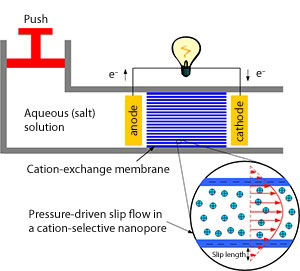| Nov 07, 2011 |
Nanoscale fluid slippage could enhance energy conversion in electrokinetic batteries
|
|
(Nanowerk News) The field of microfluidics involves manipulating tiny volumes of fluid for applications as diverse as inkjet printing and genetic engineering. It has also been shown recently that movement of fluid in microfluidic devices can be harnessed and converted into electricity. Chih-Chang Chang and Ruey-Jen Yang at the National Cheng Kung University in Taiwan have now conducted calculations that suggest this electrokinetic energy conversion could be more efficient than previously thought thanks to the strange properties of fluid flow at the nanometer scale ("Electrokinetic energy conversion efficiency in ion-selective nanopores").
|
|
"In microfluidics, liquid is pumped by applying an electrical field across a charged membrane, creating a pressure difference that drives liquid flow," explains Chang. "Conversely, electric power can be generated by applying a hydrostatic pressure through a charged membrane."
|
 |
| The operating principle of an electrokinetic micro-battery
|
|
Chang has been working to develop an electrokinetic micro-battery based on a charged membrane containing a large number of engineered nanopores that respond selectively to certain ions (see image). Inside each nanopore, a region called an electrical double layer is created adjacent to the charged surface.
|
|
"When a liquid, such as a salt solution, is forced through a nanopore under an applied hydrostatic pressure, the charges in the electrical double layer are carried downstream, inducing an electrical convection current," says Chang.
|
|
Chang and Yang initially calculated that the electrical conversion efficiency in such devices would be relatively low, around 9.7%. But then they modified their calculations to include a phenomenon known as hydrodynamic slippage, which is likely to greatly enhance flow rates at the nanoscale. "Hydrodynamic slip flow will result in an amplification of ion transport and electrical convection current through the nanopores," explains Chang, "which leads to higher efficiency in the electrokinetic micro-battery."
|
|
Thanks to this slip-flow mechanism, the researchers suggest that electrokinetic batteries could reach efficiencies exceeding 40% — a level comparable to that of existing fuel cells. They propose developing a hand-held electrokinetic battery in which a manually pumped piston drives liquid flow to generate electric power.
|
|
Intriguingly, the researchers also hope to mimic nature by using a 'synthetic tree' to drive an electrokinetic energy harvesting system. "The electric current will be driven by a negative pressure induced by evaporation from a synthetic leaf membrane," says Chang.
|

